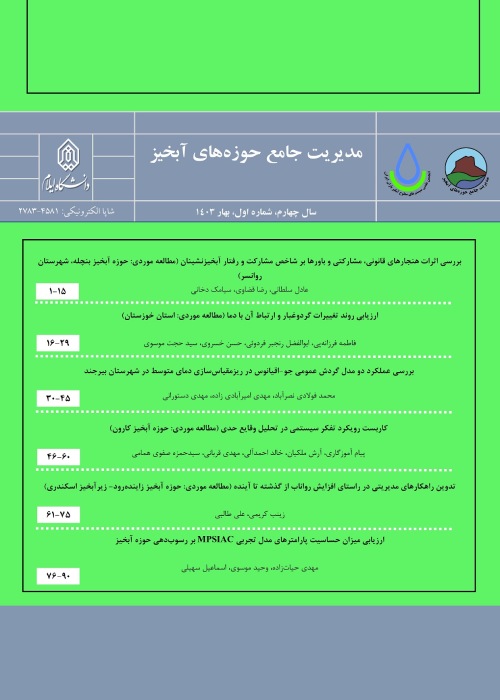Evaluation of the Sensitivity of the Empirical Model of MPSIAC Parameters on Sediment Yield in the Basin
The study of erosion and sedimentation is a crucial aspect and an integral part of watershed studies in a basin. The methods employed to prevent erosion and sedimentation play a significant role in basin management planning. However, due to the lack of accurate statistics on erosion and sediment amounts, it becomes necessary to utilize estimation models for assessing erosion and sedimentation. These models are often region-specific and may have a wide range of uncertainty in different areas. One notable benefit of modeling, regardless of its type, is its ability to analyze natural processes within the basin. On the other hand, understanding erosion and sedimentation processes in a region can be an effective step in managing, planning, and prioritizing available resources. In this research, the aim was to determine the sensitivity of the MPSIAC model to the relationships among its parameters. Additionally, the goal was to assess the model's sensitivity to changes in these parameters and their impact on sedimentation. By identifying the influential ground and atmospheric parameters, it becomes possible to prioritize their effect on water sedimentation in the region.
Through the sensitivity analysis of the model, it is possible to identify the flexibility of the model to the changes of its various parameters. It is also possible to determine the relationships between model variables and prioritize the parameters affecting the model output. Sensitivity analysis can be used in the calibration stage, in such a way that results are accurate, and time and cost are saved. In this study, to analyze the sensitivity of the MPSIAC model, first, the nine parameters of the model were examined. Then, according to the arrangement of different parameters in the structure of this model, the parameters were numbered from X1 to X9. Then, the score range of each parameter was entered in its calculation table according to the modified model of PSIAC. In this step, the average of each parameter was calculated according to its upper and lower limits. To achieve this, the nine parameters of the model were standardized, and the sedimentation rate was estimated by varying each parameter within its lower and upper limits while keeping the other parameter(s) fixed at their averages. With each change, the sediment discharge was calculated.
In the analysis of the results, the slope of the curves of the standardized parameters relative to the dependent variable (specific sediment) is considered. So that, any part of the curve that has more slope changes means that the model is more sensitive to minor changes in that parameter in that interval. In this study, the results of this sensitivity analysis reveal that the slope factor and runoff volume have a considerable influence on sediment yield. For slopes up to approximately 15%, the slope parameter has a relatively smaller impact compared to other parameters. However, as the slope value increases, its effect becomes more pronounced, indicating that high slopes (greater than 15%) have the greatest impact on sedimentation. The runoff factor exhibits a sudden increase in sensitivity at higher flow rates.
In examining the effect of different parameters on the model performance, the parameters that had the largest slope of changes can be considered as the most effective parameters in sedimentation of the basin. In other words, the model demonstrates high sensitivity to slight changes in specific peak discharge values above 20 m³/s/km2. Therefore, implementing integrated (biomechanical) management measures to control slope steepness and reduce runoff volume can be an effective strategy for mitigating sedimentation. Therefore, based on the results, the role of land factors is very important, such as slope and then runoff, in the erodibility and sediment production in basins. Of course, it should be noted that climatic parameters directly and indirectly affect the amount of peak flood discharge and should not be neglected for their importance and influence in flooding and subsequently the erodibility of the watershed.
- حق عضویت دریافتی صرف حمایت از نشریات عضو و نگهداری، تکمیل و توسعه مگیران میشود.
- پرداخت حق اشتراک و دانلود مقالات اجازه بازنشر آن در سایر رسانههای چاپی و دیجیتال را به کاربر نمیدهد.


